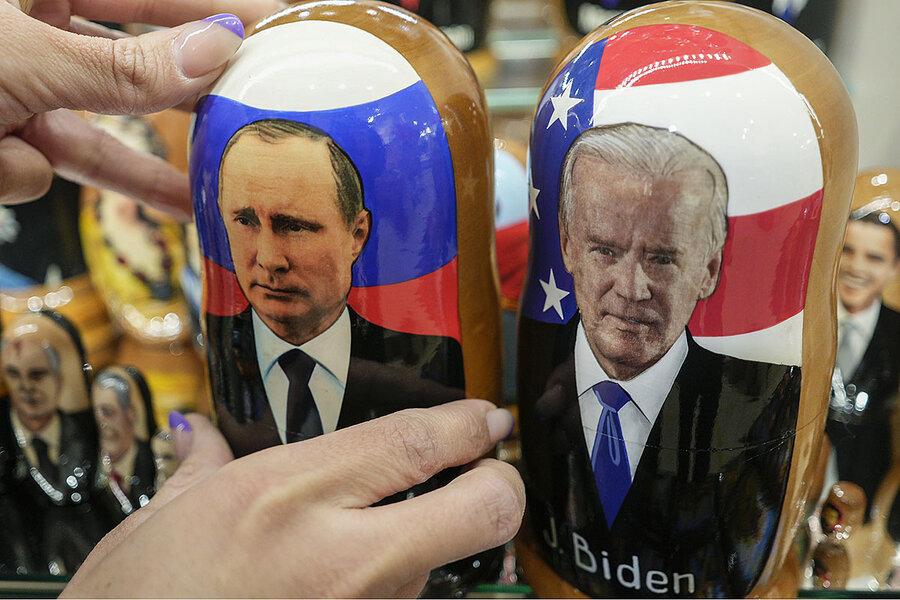Preventing accidental war: Guardrails among superpowers can help
Loading...
| London
President Joe Biden’s video call with Vladimir Putin Tuesday had one immediate goal – to warn him off invading Ukraine. But it was also part of a broader effort to address a more fundamental, long-term challenge.
That is to rebuild a framework of diplomatic stability around great power rivalries – the kind of mutually understood buffers that stopped the Cold War from heating up through miscalculation or misunderstanding.
Why We Wrote This
Beyond warding off an immediate crisis in Ukraine, President Biden’s summit with Vladimir Putin served to erect diplomatic guardrails to prevent flashpoints from becoming shooting wars.
The immediate focus is on Russian troops massing on the Ukrainian border. But U.S. officials are also deeply worried about a slow-burn crisis with China over the future of Taiwan, which Beijing has pledged to “reunite” with the mainland.
International relations are in such poor shape at the moment it will be hard for Washington to erect the “guardrails” that national security adviser Jake Sullivan talks about, or to inject greater stability into Washington’s relationships with Moscow and Beijing.
But Presidents Biden and Putin did agree to further talks, and Mr. Biden broached the idea of “strategic stability” talks with Xi Jinping when he spoke with the Chinese leader last month. Those sorts of contacts, following a Cold War model, might offer a path forward.
The immediate aim of U.S. President Joe Biden’s video summit with Russia’s Vladimir Putin on Tuesday was clear: to deter him from using the military force he is amassing on the border with Ukraine to invade that formerly Soviet, now pro-Western, state.
It was also part of a broader effort to address a more fundamental, long-term challenge.
The goal: to rebuild a framework of diplomatic stability around great power rivalries, the kind of mutually understood buffers that prevented the U.S.-Soviet Cold War from heating up. “Guardrails” is the word U.S. national security adviser Jake Sullivan has used in recent months.
Why We Wrote This
Beyond warding off an immediate crisis in Ukraine, President Biden’s summit with Vladimir Putin served to erect diplomatic guardrails to prevent flashpoints from becoming shooting wars.
Britain’s top soldier, Gen. Nick Carter, warned last month as he retired that in the absence of Cold War-era “diplomatic tools and mechanisms,” he saw an unprecedented risk of accidental war with Russia.
The immediate focus is on Russian troops. But the United States and its allies are also deeply concerned about a similar slow-burn crisis with China over the future of the island democracy of Taiwan, which Chinese leader Xi Jinping has vowed eventually to “reunite” with the mainland, by force if necessary.
The Biden administration’s stability project is not going to be easy.
That’s in part because the deepening chill in international relations has reduced the breadth of trusted channels of communication, or formal negotiation, with both Moscow and Beijing.
But there’s a deeper problem. World politics have become more unstable since the collapse of the Soviet Union, a trend accelerated by the presidential election of Donald Trump in the U.S. and the rise of populist strongmen in a number of other countries.
Western Cold War-era alliances have been loosening. That trend, too, was fueled by Mr. Trump’s “America First” approach to international relations. Mr. Biden’s scant consultation with allies over the military withdrawal from Afghanistan also left them wondering whether they can rely on the kind of U.S. engagement that marked the Cold War years.
The Ukraine crisis is now providing a test of whether this system of new guardrails – and a broader framework of stability – is feasible.
Significantly, Mr. Biden and his top officials spent weeks ahead of the video call consulting with European allies on a common approach. So the stern message he delivered to Mr. Putin – that there will be major economic and strategic costs should he invade – came with the allies also on board.
The wider stability agenda was also evident. The very fact of the summit contributed to it: The virtual meeting gave Mr. Putin a high-profile place on the geopolitical stage, something he feels Washington has been denying him, especially now that China has emerged as its primary competitor.
Mr. Putin’s agenda may be starkly different from Washington’s, but both sides’ readout of the meeting spoke of follow-up talks.
U.S. officials seem to hope that negotiations on a wide range of issues, from Ukraine to cyberwarfare, will build greater stability in U.S.-Russia relations. And that the clear, allied message on the scale and range of sanctions being readied will provide a guardrail against an invasion.
But what of China? Stabilizing relations there could prove even tougher.
Step one – putting in place a “guardrail” on Taiwan – is underway. U.S. Secretary of State Antony Blinken has publicly cautioned China that it would be making a “serious mistake” if it used force. And last week, former Prime Minister Abe Shinzo of Japan, a key U.S. ally, said a Chinese invasion of Taiwan would also be a “Japan crisis, and therefore for the Japan-U.S. alliance.”
Yet American officials would like to erect firmer guardrails, and inject much greater stability, as China expands and modernizes its military. Satellite photos show that Beijing is building new missile silos as it abandons its longtime doctrine of “minimum deterrence.” And China recently tested a hypersonic missile that could evade detection or interception by U.S. space-based defenses.
The Cold War model involved U.S.-Soviet talks on high-tech weaponry, which helped reduce the danger of miscalculation on either side. That’s something that Washington would like to emulate in the Chinese context, as Mr. Biden suggested in a video call with Mr. Xi last month when he proposed “strategic stability” talks.
Still, substantive negotiations don’t seem likely soon.
It took a bout of nuclear brinkmanship – the 1962 Cuban missile crisis – to prod Washington and Moscow into installing a nuclear hotline to avert further such near-catastrophes.
One indication of how far the U.S. and China have still to go toward strategic stability? There is no such nuclear hotline to Beijing.









